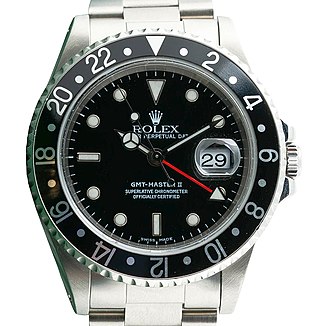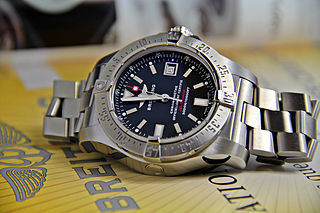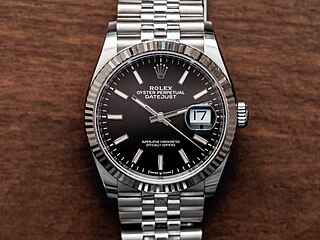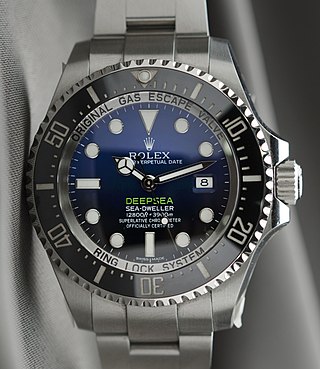
A watch is a portable timepiece intended to be carried or worn by a person. It is designed to keep a consistent movement despite the motions caused by the person's activities. A wristwatch is designed to be worn around the wrist, attached by a watch strap or other type of bracelet, including metal bands, leather straps, or any other kind of bracelet. A pocket watch is designed for a person to carry in a pocket, often attached to a chain.

Rolex SA is a Swiss watch designer and manufacturer based in Geneva, Switzerland. Founded in 1905 as Wilsdorf and Davis by Hans Wilsdorf and Alfred Davis in London, the company registered Rolex as the brand name of its watches in 1908 and became Rolex Watch Co. Ltd. in 1915. After World War I, the company moved its base of operations to Geneva because of the unfavorable economy in the United Kingdom. In 1920, Hans Wilsdorf registered Montres Rolex SA in Geneva as the new company name ; it later became Rolex SA. Since 1960, the company has been owned by the Hans Wilsdorf Foundation, a private family trust.

Omega SA is a Swiss luxury watchmaker based in Biel/Bienne, Switzerland. Founded by Louis Brandt in La Chaux-de-Fonds in 1903, the company formerly operated as La Generale Watch Co. until incorporating the name Omega in 1903, becoming Louis Brandt et Frère-Omega Watch & Co. In 1984, the company officially changed its name to Omega SA and opened its museum in Biel/Bienne to the public. Omega is a subsidiary of The Swatch Group.

A chronograph is a specific type of watch that is used as a stopwatch combined with a display watch. A basic chronograph has an independent sweep second hand and a minute sub-dial; it can be started, stopped, and returned to zero by successive pressure on the stem. More complex chronographs use additional complications and can have multiple sub-dials to measure seconds, minutes, hours and even fractions of a second. In addition, many modern chronographs use moveable bezels as tachymeters for rapid calculations of speed or distance. Louis Moinet invented the chronograph in 1816 for use in tracking astronomical objects. Chronographs were also used heavily in artillery fire in the mid to late 1800s. More modern uses of chronographs involve aircraft piloting, auto racing, diving and submarine maneuvering.

ETA SA Manufacture Horlogère Suisse designs and manufactures quartz watches and both hand-wound and automatic-winding mechanical ébauches and movements. Commonly referred to as ETA, the company is headquartered in Grenchen, Switzerland, and is a wholly owned subsidiary of The Swatch Group.

Oris SA is a Swiss luxury manufacturer of mechanical watches. The company was founded in 1904 and is based in Hölstein in the canton of Basel-Landschaft.

Omega Speedmaster is a line of chronograph wristwatches produced by Omega SA. While chronographs have been around since the late 1800s, Omega first introduced this line of chronographs in 1957. Since then, many different chronograph movements have been marketed under the Speedmaster name. Astronaut Walter Schirra was the first person to wear one in space in 1962 during his Mercury-Atlas 8 mission. The manual winding Speedmaster Professional or "Moonwatch" is the best-known and longest-produced; it was worn during the first American spacewalk as part of NASA's Gemini 4 mission, and was the first watch worn by an astronaut walking on the Moon during the Apollo 11 mission. The Speedmaster Professional remains one of several watches qualified by NASA for spaceflight, and is still the only one so qualified for EVA. The Speedmaster line also includes other models, including analog-digital and automatic mechanical watches.

Automatic quartz is a collective term describing watch movements that combine a self-winding rotor mechanism to generate electricity with a piezoelectric quartz crystal as its timing element. Such movements aim to provide the advantages of quartz without the inconvenience and environmental impact of batteries. Several manufacturers employ this technique.

The Rolex Oyster Perpetual Date GMT Master is part of the Rolex Professional Watch Collection. Designed in collaboration with the now defunct Pan American Airways of the United States for use by their pilots and navigators, it was launched in 1954.

The Rolex Oyster Perpetual Submariner is a line of sports watches designed for diving and manufactured by Rolex, resistant to water and corrosion. The first Submariner was introduced to the public in 1954 at the Basel Watch Fair. It was the first watch to be waterproof up to 100 metres (330 ft). The Rolex Submariner is considered "a classic among wristwatches", manufactured by one of the most widely recognized luxury brands in the world. Due to its huge popularity, there are many homage watches by well-established watchmakers, as well as illegal counterfeits. The Rolex Submariner is part of Rolex's Professional line.

A diving watch, also commonly referred to as a diver's or dive watch, is a watch designed for underwater diving that features, as a minimum, a water resistance greater than 1.1 MPa (11 atm), the equivalent of 100 m (330 ft). The typical diver's watch will have a water resistance of around 200 to 300 m, though modern technology allows the creation of diving watches that can go much deeper. A true contemporary diver's watch is in accordance with the ISO 6425 standard, which defines test standards and features for watches suitable for diving with underwater breathing apparatus in depths of 100 m (330 ft) or more. Watches conforming to ISO 6425 are marked with the word DIVER'S to distinguish ISO 6425 conformant diving watches from watches that might not be suitable for actual scuba diving.

The Rolex Oyster Perpetual Datejust is a self-winding chronometer manufactured by Rolex. Launched in 1945, the Datejust was the first self-winding chronometer wristwatch to indicate the date in a window on the dial. Today, it is available in a variety of sizes from 28mm to 41mm, in stainless steel, two-tone gold, and solid gold versions.Today, it exists in a variety of sizes from 28mm to 41mm, in stainless steel, two-tone, and solid gold versions.

The Rolex Oyster Perpetual Date Sea-Dweller is a line of diver's watches manufactured by Rolex, with an underwater diving depth rating of 1,220 meters and up to 3,900 metres (12,800 ft) for the Sea-Dweller Deepsea variant. In 2022 the dimensionally large Deepsea Challenge Sea-Dweller variant with an official depth rating of 11,000 metres (36,090 ft) was added to the line. The Rolex Sea-Dweller is part of Rolex's Professional line.
The J12 is a line of Swiss made luxury watches introduced in 1999 by French haute couture house Chanel. The J12 was launched in 1999 and is considered as a unisex watch. The watch was designed by the artistic director of the house, Jacques Hélleu, who found inspiration in the two worlds he loved most: automobiles and sailing. Chanel uses highly scratch-resistant ceramic for the watch's case and bracelet. Other materials are used as well, such as titanium and for one of the house's limited edition watches, sapphires were used to create the entirety of the bracelet and case.

Gérald Charles Genta was a Swiss watchmaker and artist. He is known for his eponymous lines of timepieces, such as Gerald Genta and Gerald Charles, as well as his design work with other high-end watch manufacturers, including IWC, Omega, Universal Genève, Patek Philippe and Audemars Piguet. Genta created the Patek Phillipe Nautilus and the Audemars Piguet Royal Oak, to date, the best-selling models of both houses. He is regarded as one of the most influential people in the history of horology.

The Omega Seamaster is a line of automatic winding mechanical diving watches from Omega with a history that can be traced back to the original water-resistant dress watch released in 1948. The Seamaster collection is perhaps best known today for the Seamaster Diver Professional 300m model that has been worn in the James Bond movie franchise since 1995. Originally conceived as a dressy, water-resistant timepiece, the Omega Seamaster has evolved to a robust sports watch line typically with a stainless steel case, robust water resistance, and an official certified chronometer certified movement within. The Diver Professional 300m is most famous for its "train track" five link steel bracelet, its helium release valve at the 10:00 position, the wave pattern dial on certain model generations, and the skeletonized handset.

The Rolex Oysterquartz was a quartz watch made by Rolex.

The Omega Marine Chronometer was the first quartz wristwatch ever to be awarded certified status as a marine chronometer. The watch was made by Omega SA and developed by John Othenin-Girard and is one of the most accurate non thermo-compensated production watches ever made, keeping time to within 1 second per month

The Omega Electroquartz was introduced in 1969 as the first production Swiss quartz watch. It was the collaboration of 20 Swiss watch companies and the movement was utilised by Rolex, Patek Phillipe and Omega amongst others. The Beta 21 movement used in the Electroquartz was accurate to 5 seconds per month, far better than any automatic or manual wind movement of the day.

The Omega Bullhead was introduced in 1969 as part of the Chronostop range, it was marketed as drivers / rally watch and was nicknamed the "Bullhead" because of the configuration of the winding crown being located at 12 o'clock with the chronograph pushers on either side.



















